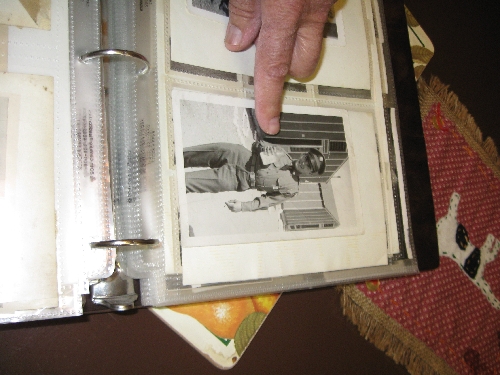Local man among first to fly military drones
Milton Zaslowsky was just a kid of 14 when he joined the U.S. Army in 1945. Somehow, the military let the little matter of his age slip by and assigned him to the U.S. Army Air Force. He was soon "playing" with remote-controlled airplanes.
It wasn't all fun and games. The drone planes were the clay pigeons in the military's version of skeet shooting. Zaslowsky and about 100 of his cohorts flew the planes. Other soldiers trained huge guns on the planes until they shot them down.
The shooters were being trained as anti-aircraft gunners. The program took place in a remote area of White Sands, N.M. , far from curious eyes.
"No one knew of them (the drone planes)," Zaslowsky said. "It was the best-kept secret in the whole world."
Zaslowsky and his fellow drone pilots in the RACATs (Radio Controlled Air Plane Target) unit used a transmitter controlled by a joy stick -- left, right, forward and up or down -- to take the drones as high as 2,000 feet.
The trickiest part, he said, was the takeoff. If he didn't take control of it perfectly and pull back on the joy stick to gain altitude immediately, the drone would crash. After his first few tries, he no longer crashed any drones on take off. In fact, he became adept at flying them, accomplishing loop de loops, near stalls and dive-bomb moves.
While the remote operators attempted moves to evade being hit, they also congratulated the shooters whenever a drone was destroyed.
"It was fun, like kids playing with a (toy) airplane," Zaslowsky said.
Back then, he said, no one had envisioned drones that could carry spy cameras or bombs.
The unmanned planes joined the anti-aircraft training program after a short-lived, more lethal idea. Soldiers had been training the big guns at targets towed behind B-17 and B-29 bombers. It seems one of the shooters over-anticipated where the target would be and blasted a huge hole in one of the planes. It made an emergency landing.
"The next day, the pilot says, 'You'll never see us do this again,' " Zaslowsky said. "After that, they (started using) the drones."
Intentionally shooting down a drone is anathema to some who like to fly. Gary, who asked that his last name not be used, is a member of the Las Vegas Soaring Club and flies his remote-controlled models regularly.
"I'd be pretty annoyed if someone tried to destroy my plane while I was flying it," he said. "I typically put anywhere from three to 10 hours into building and setting up my planes ... so, having my plane knocked from the sky intentionally would be heartbreaking,"
The drones Zaslowsky flew had a wing span of about 8 feet. Early versions flew with gas-powered, two-cylinder engines and had a single prop. They had no landing gear and were launched via a catapult. Landing was not a concern as the idea was to shoot them to smithereens. The pieces dropped out of the sky and landed about 300 yards away.
Zaslowsky said he thought the military was stupid to purposely destroy the drones.
"But it was the government's money, and they had thousands of them," he said.
As soon as one drone was destroyed, another was pulled out to take its place. Later versions had a more beefed-up engine and came with landing gear.
Zaslowsky recalled standing in the wrong place soon after he got to White Sands: in the middle of the 90 mm and 120 mm guns.
"I didn't know they were about to go off, but when they did," he said, "you could feel it ... It knocked me to the ground."
Another time, a gun exploded when its munitions got wet. Luckily, no one was killed, but "a lot of guys took shrapnel," Zaslowsky said. "I happened to be standing behind a tractor truck when it happened. So, I was safe."
White Sands is now a huge government installation. Back then, it was raw desert. For the months that Zaslowsky was there, it was winter and bitterly cold at night. The 36,000 soldiers bunked in tents. They did not have cots but slept on the ground, bundled up in their sleeping bags.
The latrines were holes in the ground. Showers were accomplished by catching the spray from a water truck, similar to how construction crews keep dust down at Las Vegas building sites.
Zaslowsky was singled out, awarded with an Honor Soldier award and offered a full-ride scholarship to West Point. He declined, thinking his lack of a high school education would cause him to be too far behind other classmates.
In all, he spent eight years in the military, left with the rank of staff sergeant and went on to have a successful career as a manufacturer of steam generators and in irrigation installation.
Contact Summerlin/Summerlin South View reporter Jan Hogan at jhogan@viewnews.com or 387-2949.
Military Drones have
a hollywood history
Reginald Denny was a World War I British flier who moved to Hollywood to become an actor and stunt pilot with more than 100 movies to his credit. He was a hobbyist of radio-controlled model airplanes. With World War II looming, Denny thought his radio-controlled planes would make perfect target drones for anti-aircraft gunners and developed a prototype with a 12-foot wingspan. The U.S. Army ordered 53 of his invention. After the attack on Pearl Harbor, the value of his target drones was taken more seriously. The U.S. military would eventually buy nearly 15,000 over the course of that war.
Source: Internet Movie Database, imdb.com















